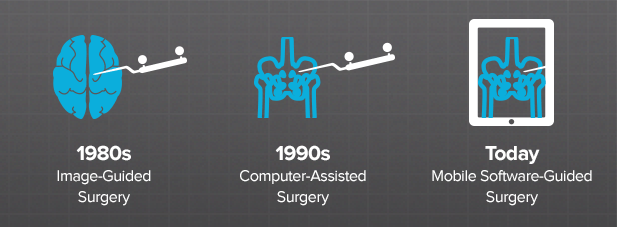
Since the 1980s, surgeons have been using surgical navigation to visualize patient anatomy. The system is designed to help assess the case, plan the surgery and actually mirror the real human anatomy on screen – helping to guide the surgeon through important surgical steps taken during the procedure.
In orthopedic surgery, software-guided systems have been used for more than 15 years now, making them an established and well-known addition to hip and knee procedures worldwide. Today, surgeons use software-guided systems with mobile—sometimes even handheld—devices. For example, Brainlab Dash® software runs on an iPod touch®, utilizing the handheld device in a dedicated holder as the system’s monitor directly at the surgical site.1
While software-guided surgery has been instrumental in the development of ‘robotic’ technologies, the navigation system does not take the place of your doctor, but is rather a guiding tool used during surgery. Surgical navigation enables your doctor to plan your hip procedure before surgery and helps guide the surgeon’s instruments during surgery, supporting enhanced overall accuracy.2 Surgical navigation is a technique to help place your hip implants. It is not the implant itself; therefore, none of the instruments used during surgical navigation stay inside your body after surgery.
The Food and Drug Administration (FDA) is responsible for ensuring public safety by regulating medical devices. Surgical navigation systems are considered medical devices and therefore are subject to review and clearance by the FDA.
As you may already know, insurance companies pay hospitals per procedure, including all goods used in that procedure, so each case is different depending on the insurance company and hospital. Hospitals and surgeons who use software-guided technology during the surgical procedure often build the costs of navigation into their total costs for the procedure.
® 2014 Brainlab AG and Brainlab Inc. All rights reserved.
® iPad, iPod and iPhone are registered trademarks of Apple Inc.